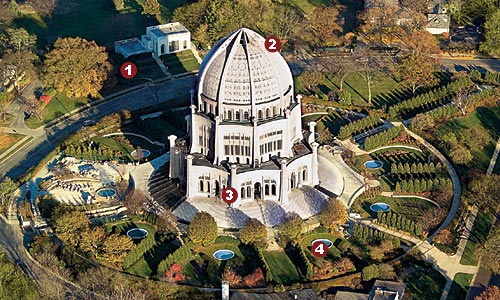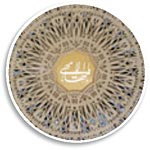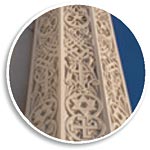|
Is it a rocket ship? Was it a refueling station for German U-boats? Does it house a white whale? Those are just a few of the bizarre rumors that have swirled around the Baha’i House of Worship in Wilmette since its completion in 1953 (official answers: no, no, and no). But no matter what the tall tales, the nearly 20-story-high domed temple along the lakeshore does have a certain mystique. Open to the public with free admission, it receives about 250,000 visitors annually-even though only about 4,000 Baha’i (pronounced: buh-HIGH) worshipers live around Chicago.
1. The temple’s architect, the French Canadian Louis Bourgeois, lived in downtown Chicago when the project began, but chose to shorten his commute, building a studio and home across the street from the temple, on Sheridan Road. He died at 74 in 1930, more than 20 years before the building’s completion. His studio home is now used as a meeting place for U.S. Baha’i elected delegates.
2. Measuring 135 feet from floor to ceiling, and 72 feet in diameter, the dome represents unity-a central theme of the Baha’i faith. At the height of the dome’s ceiling is an inscription that has been a source of misinterpretation. Some have said the writing resembles the word “evil” in English; in fact, the script is Arabic calligraphy that translates to “Oh, Glory of the Most Glorious.” The auditorium inside seats 1,200 and was designed as a sanctuary where people of all faiths can pray and meditate.
3. Intricate carvings depicting the symbols of other religions on the nine exterior pillars represent the central Baha’i canon: that all major religions are actually reflections of a single divine source. The symbols are arranged in chronological order-from bottom to top-on the pillars. That’s why the swastika is at the base, with the Star of David above it (although it was adopted by the Nazis, the swastika as a religious symbol dates back nearly 5,000 years). Baha’i is the newest world religion-so its symbol, a nine-pointed star, tops each pillar. 4. In addition to domes, all Baha’i temples share two other design elements: they are always nine-sided (the number nine symbolizes completeness for Baha’is); and all temples are encircled with gardens (Baha’i readings contain metaphors likening human beings to flowers in a garden). The Wilmette temple’s grounds feature rows of Chinese juniper trees, nine fountains, and two dozen varieties of flowers, including 20,000 new tulip bulbs planted each fall. >> Founded in Persia, now Iran, in 1844, the Baha’i faith is centered on the belief that the world’s religions are united-originating from the same God but revealed through different messengers in different times throughout history. There are seven Baha’i temples worldwide; Wilmette’s is the oldest. photography: © 2006 Aerial Images Photography, insets Rob Goodwin |
||||





